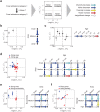Highly Multiplexed Imaging Uncovers Changes in Compositional Noise within Assembling Focal Adhesions
- PMID: 27519053
- PMCID: PMC4982658
- DOI: 10.1371/journal.pone.0160591
Highly Multiplexed Imaging Uncovers Changes in Compositional Noise within Assembling Focal Adhesions
Abstract
Integrin adhesome proteins bind each other in alternative manners, forming within the cell diverse cell-matrix adhesion sites with distinct properties. An intriguing question is how such modular assembly of adhesion sites is achieved correctly solely by self-organization of their components. Here we address this question using high-throughput multiplexed imaging of eight proteins and two phosphorylation sites in a large number of single focal adhesions. We found that during the assembly of focal adhesions the variances of protein densities decrease while the correlations between them increase, suggesting reduction in the noise levels within these structures. These changes correlate independently with the area and internal density of focal adhesions, but not with their age or shape. Artificial neural network analysis indicates that a joint consideration of multiple components improves the predictability of paxillin and zyxin levels in internally dense focal adhesions. This suggests that paxillin and zyxin densities in focal adhesions are fine-tuned by integrating the levels of multiple other components, thus averaging-out stochastic fluctuations. Based on these results we propose that increase in internal protein densities facilitates noise suppression in focal adhesions, while noise suppression enables their stable growth and further density increase-hence forming a feedback loop giving rise to a quality-controlled assembly.
Conflict of interest statement
Figures




References
MeSH terms
Substances
LinkOut - more resources
Full Text Sources
Other Literature Sources
Molecular Biology Databases
Miscellaneous

